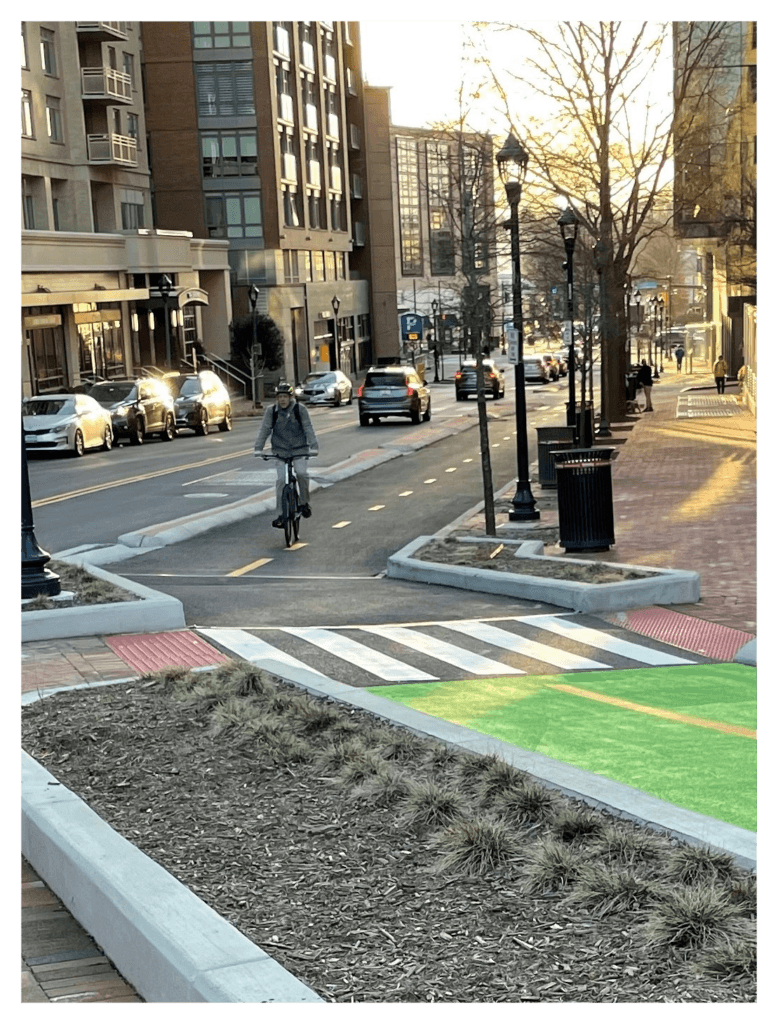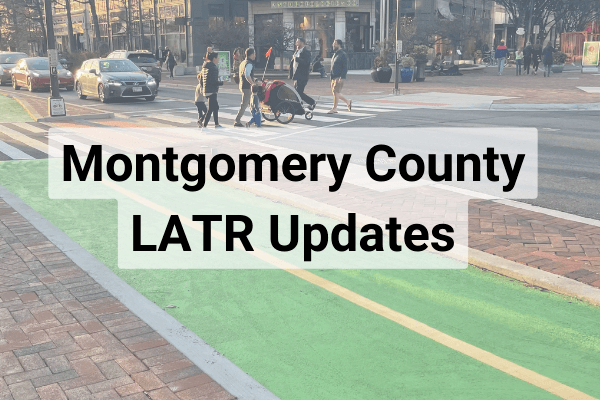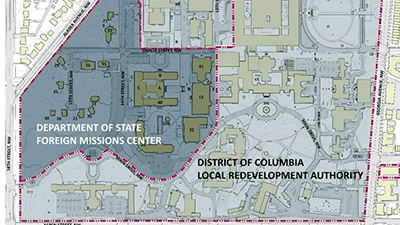Katie Wagner and Will Zeid from our DC office have been working for the last couple of months as development advocates helping lead a stakeholder group with Montgomery County Transportation Staff to update the Local Area Transportation Review (LATR) guidelines to address significant issues with the proportionality of improvements brought about with the most recent updates to the traffic study guidelines. The original guidelines had the potential to trigger requirements for excessively expensive improvements/mitigation/payments for offsite improvements that were disproportional to the impact of the proposed development.
Through coordination meetings, work sessions, and three Planning Board Hearings, our stakeholder group of area transportation engineers, civil engineers, and land use attorneys worked with County Staff to develop updates to the LATR guidelines. The proposed changes were approved on March 3, 2022 by the Montgomery County Planning Board. The updated guidelines went into effect immediately and are in place for all currently submitted and future applications within Montgomery County.
The guidelines adopted a new cap for called the “LATR Proportionality Guide.” It sets an upper limit for the combined value of off-site multimodal improvements to be constructed and/or paid for via fee-in-lieu for the multi-modal adequacy tests. The Planning Board also adopted new processes to approve waivers for master planned pedestrian and bicycle improvements for de minimis residential and commercial projects via a reduced fee-in-lieu payment. These updates were developed through a compromise between public and private sector considerations and concerns. Gorove Slade will be continue to engage with the stakeholder group and Montgomery County going forward.
Key Takeaways
Predictability. The most difficult to predict cost for developers has typically been the scope and costs of off-site improvement. This revision helps give land sellers and developers transparency of future costs for the non-auto related improvement requirements brought on by the Growth and Infrastructure Policy.
Proportionality. Each new development contributes proportionally to the collective cost of maintaining and improving the non-auto infrastructure that benefits the community.
By sharing the financial responsibility costs are applied equitably and avoids the first developer in an area that has not had recent development bearing the cost alone. A single landowner or group of homebuyers will not be overburdened with non-auto infrastructure costs brought on by the requirements of the Montgomery County master plans.
These updates provide a meaningful and, in some cases, critical step forward to helping Applicants identify potential exposure early on in the process and find a path forward when significant improvements are required to meet the new Montgomery County LATR improvement requirements.
We applaud the Montgomery County Transportation Staff for championing these updates and working with the development community to identify improvements to the guidelines that factor in both public and private considerations. We look forward to our continued stakeholder meetings with the team as we all strive to improve the development review process in the County.
Detailed Summary

Off-Site Improvement Cap (LATR Proportionality Guide)
A new cap has been created for off-site improvements, named the “LATR Proportionality Guide”, that sets an upper limit for the combined value of offsite improvements to be constructed and/or paid for via fee-in-lieu for the multi-modal adequacy tests listed below:
- Pedestrian Adequacy Test (PLOC, ADA & Streetlights)
- Bicycle Adequacy Test (Master Planned Bike Facilities)
- Bus Transit Adequacy Test (Bus Shelters and Enhanced Amenities)
- Vision Zero (Improvements accounted for in above tests, County has said they do not have current plans to incorporate additional improvement requirements for this test)
This cap is exclusive of the value for any improvements along the site frontage. While we suggested and worked towards a cap for frontage improvements, Staff felt that would involve a policy change and it was deferred for future discussion.
The cap does not place a limit on improvements required as a result of vehicular analyses, such as intersection improvements; however, if such improvements reduce pedestrian, bicycle and/or bus transit deficiencies, then they can be counted towards the LATR Proportionality Guide (the cap).
The Board still reserves the right to address unique cases where the new updates still do not achieve a “proportional” result for a project, but the goal of the updates is to have that be a less common occurrence. Further, the cap is only an upper limit, and if the sum of improvements identified is below that number, then only the identified improvements would be required.
The formula for calculating the cap is shown below:
LATR Proportionality Guide = Extents of Development x Rate Per SF or DU x Adjustment Factor for Policy Area
- Extents of Development refers to the total proposed SF for commercial uses and number of dwelling units for residential. Note it is total units, not net new, and credit for existing is accounted for when scoping the initial LATR study and extents of the study.
- The rate per SF/DU is the same for all policy areas and varies by type of commercial and type of residential
- There are separate adjustment factors for each policy area and for commercial vs. residential
A quick review of several cases shows significant reductions in offsite improvements for some cases. For examples, a small change in use application had up to $400k+ in identified required bike lanes before the updates but is now capped at below $10k with the updates. Without the new cap, this project likely would not have been able to move forward.
Frontage Improvement Fee-In-Lieu and De Minimis Criteria
A new process has been implemented to approve waivers for master planned pedestrian and bicycle improvements for de minimis residential and commercial projects via a reduced fee-in-lieu payment. This helps address the sometimes disproportional requirements brought on by the master and sector plans for small developments. The updates also include a new formalized process for identifying when a payment for fee-in-lieu for frontage improvements for all projects, small or large, will be permitted.
De Minimis Payments for Smaller Projects
-
- Criteria 1: Projects with five (5) of fewer residential units may make a de minimis payment in lieu of constructing master-planned bikeable shoulders and conventional bike lanes.
- De Minimis Fee Formula: Cost per linear foot X # of proposed units X the “Lot width at front building line (min)”
- Criteria 2: Projects with three (3) of fewer residential units may made a de minimis payment in lieu of constructing master-planned sidepaths and sidewalks when the improvements would:
- Require relocating utilities, utility poles and stormwater facilities or require large retaining walls.
- Have an excessive length, defined as:
- Projects with one frontage: frontage length > 2 X # of proposed units X the “Lot width at front building line (min)”
- Projects with multiple frontages: frontage length > 3 X # of proposed units X the “Lot width at front building line (min)”
- De Minimis Fee Formula: Cost per linear foot X # of proposed units X the “Lot width at front building line (min)”
- Criteria 3: Commercial projects may make a de minimis payment in lieu of constructing pedestrian and bicycle frontage improvements if they meet the following conditions:
- New building additions less than 5,000 sf and that generate less than 40 net new peak hour person trips
- Changes in use with no additional square footage and that generate less than 40 net new peak hour person trips
- De Minimis Fee Formula: Cost per linear foot X Length of frontage
- The de minimis payment costs per linear foot are to be updated every odd numbered year by the Planning Board and would be set currently at:
- $115.20 per linear foot
- This represents a potentially significant savings for some smaller projects; however, the Applicant retains the right to construct the facilities rather than making a payment.
Permitted Fee-In-Lieu for Frontage Improvements for Any Sized Project
- This process does not limit the cost of the improvements but does provide criteria for identifying cases where a fee-in-lieu would be allowed or a combination of constructing partial improvements and providing a fee-in-lieu for the balance of the deferred improvement.
- The total value of the deferred improvement is to be determined by MCDOT based on the “permanent” design condition as defined by the Complete Streets Design Guide, the Bicycle Master Plan and other master and sector plans.
- The following factors will be considered as reasons to support payments in lieu of construction:
- Severe Environmental Impacts
- Construction of necessary improvements would impact wetlands or other environmentally sensitive areas.
- Changes to the Roadway Section that Would be Unsafe
- Removal of vehicular lanes along high volume roadways that may lead to unsafe conditions for vehicles and bicycles
- Continuity of Bikeways
- The improvement includes a bicycle facility that would not connect to adjacent suitable connections
- Timing with a Public Project
- A public project is planned/funded that will include the improvements, but timing does not align with the subject project
- State Highway Access Permits
- Maryland State Highway Administration would not approve the necessary improvement within their ROW.
- Severe Environmental Impacts
The Montgomery County Planning Board Thursday, March 3, 2022 Agenda
Revisions to the 2021 Local Area Transportation Review Guidelines
- Criteria 1: Projects with five (5) of fewer residential units may make a de minimis payment in lieu of constructing master-planned bikeable shoulders and conventional bike lanes.
 March 8, 2022
March 8, 2022
